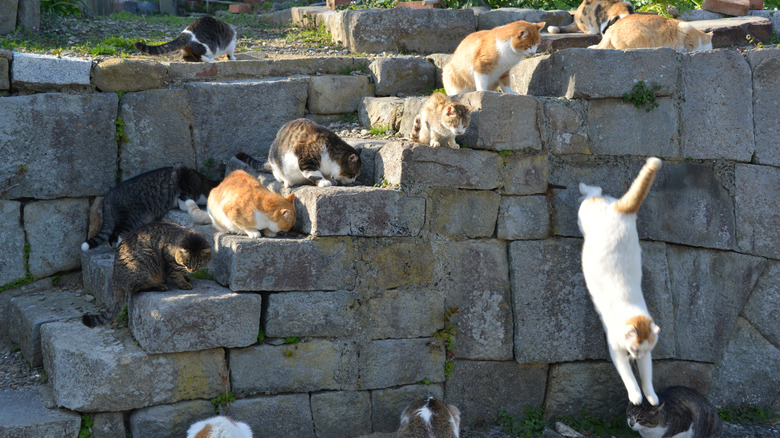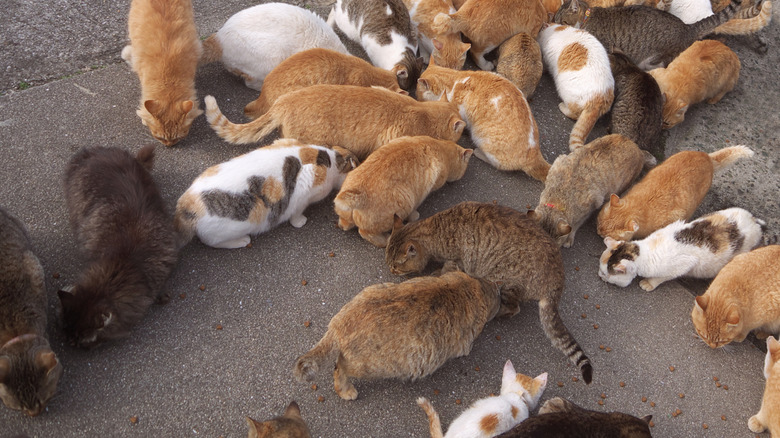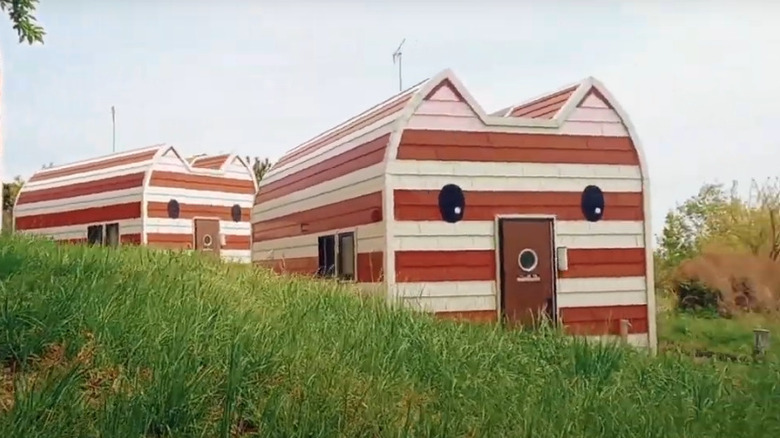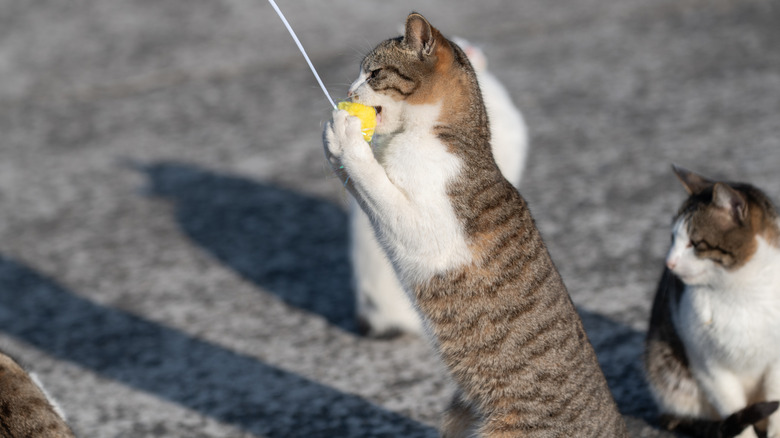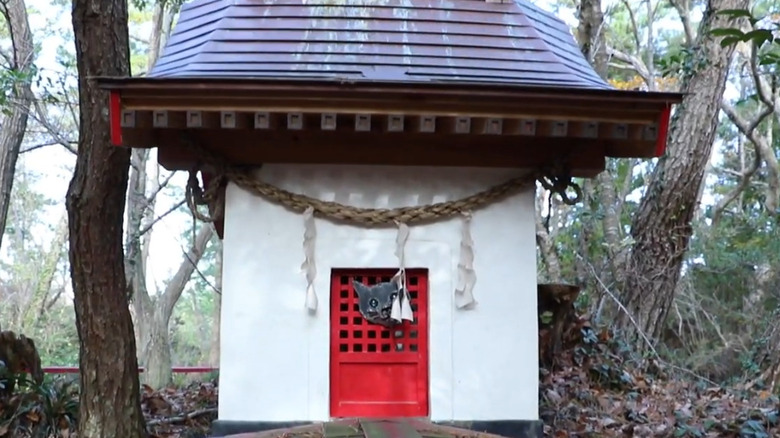5 Cutest Things To Do On Japan's Cat Island
Imagine combining your love of travel with your love of cats. A trip to Japan gives you that opportunity in a fun and memorable way. Millions of tourists visit the country every year for its ancient temples, historic sites, cherry blossoms, and futuristic capital, but there's a lesser-known attraction of interest: the cat islands. Japan is home to 11 of them, where dozens of cats roam freely and live carefree lives. Two of the most popular ones, Aoshima and Tashirojima, offer visitors several cute things to do that involve unforgettable feline encounters.
Aoshima is located in the Seto Inland Sea off the coast of Shikoku in Ehime Prefecture in southwest Japan. Centuries ago, cats were brought to this fishing village to eliminate mice on fishing boats. The cats quickly multiplied and far outnumbered the human residents, reaching over 200 in 2019. The population has declined since then, after the Aoshima Cat Protection Society implemented a spay and neuter program.
In northeastern Japan, Tashirojima sits just off the coast of Ishinomaki City in Miyagi Prefecture. This site features about 150 street cats — about double the number of humans. Similar to Aoshima, cats were introduced to the island hundreds of years ago for rodent control, but on this island, the goal was to protect silkworm farms. Today, you can feed the cats, play with them, or enjoy other cat-related activities on one or both islands.
Feed the cats on Aoshima
Although the island residents take care of the cats' meals, you can feed the kitties, too, if you'd like, but only in designated areas. Just don't expect to buy a bag of kibble on the island; Aoshima has no stores, cafes, or restaurants, so you'll have to bring cat food and treats from the mainland. Some cats might eat directly from your hand, but if you're concerned about getting bitten by accident, place the food on the ground instead. The cats are semi-feral, so although they live outdoors, many are very comfortable around humans and will even welcome some head and chin scratches.
Remember to bring a trash bag to discard any food packaging, and don't overfeed. Make a goal to leave the area cleaner than you found it. After you're done feeding, you can donate any extra packaged food in a designated donation box for the villagers to use later.
Aoshima draws visitors every year, thanks to social media and online articles about it, but it was never meant to become a tourist spot, hence the lack of stores and eateries. Tashirojima, in comparison, is a little more tourist-friendly with overnight accommodations and other facilities. However, unlike on Aoshima, Tashirojima locals discourage tourists from feeding the felines. That's because they keep the cats well fed throughout the day, with no need for assistance from visitors.
Stay in a cat-themed cabin on Tashirojima
You won't find any hotels or comparable accommodations on Aoshima, but you will on Tashirojima — specifically at a campground called Manga Island. The site features several whimsical cabins designed to resemble a cat's face on the outside, with interiors decorated in cat-themed artwork created by renowned Japanese manga artists. Every cabin is topped with a playful cat-ear-shaped roof and two large, round circles on the siding to mimic a cat's eyes. Some even have a set of diagonal lines to represent whiskers.
These structures offer an overnight experience unlike any other, with all the standard accommodations you'd expect from a cabin, including bunk beds. Choose between a one-room lodge that accommodates five guests and a two-bedroom option that accommodates six. Outside the cabins, you'll find picnic tables where you can enjoy your meals. You won't find many store or restaurant options on the island, though, so be sure to bring your own food.
During your stay, there's a pretty good chance you'll spot some cats hanging around outside your cabin, fueled by curiosity about the newest guests. Feel free to interact with these feline residents and snap all the pics you want. Whether you plan to stay the night in a cat-themed cabin or just pass through, Manga Island is definitely worth a visit. You can book your stay or learn more about it in the Manga Island Guide.
Bring toys to play with the cats at both islands
Just like every other cat, the Japanese island cats don't just enjoy eating; they love to play, too. Feel free to bring small, lightweight toys to turn your island visit into a full-on play session. If you're a cat owner, you already have a good idea of which cat toys are the biggest hits. But, since no two cats are exactly alike, and you might encounter dozens during your trip, you might want to bring a variety. Toys that they'll want to chase, like feather wands, soft toys, and string toys, are all good options on either cat island.
On Tashirojima, cats are said to bring good luck, so playing with these animals and lifting their spirits just might put the human residents in a good mood, too. It's also worth mentioning that at 1.2 square miles, this island is more than six times larger than Aoshima, which is only about 0.19 square miles. This means you and the cats will have more opportunities to spread out on Tashirojima while you play together.
Keep in mind that on both islands, the cats might not be in the mood to play at the time you arrive, or they may not be as lively as you'd like. You might catch them while they're trying to relax or sunbathe, or while they're eating. Don't force them to interact. Instead, you may want to return later or leave the toys with a resident if you don't plan to take them back with you.
Visit the Cat Shrine on Tashirojima
In the United States, cats are typically viewed as pets/family members, but they hold a much deeper cultural significance in Japan, including on the island of Tashirojima. The Japanese generally adore these animals, but one day, a cat was killed during a tragic accident. Heavy with remorse and grief, the fishermen involved in the incident enshrined the cat between the villages of Odomari and Nitoda. The site became known as Neko Jinja, or the Cat Shrine.
Today, the Cat Shrine features cat statues, figurines, and offerings left behind by residents and visitors who wanted to honor other lost cats. Even if you don't wish to honor a cat yourself with your own offering or object, you might still appreciate the artistic appearance of the shrine.
If the shrine will be your first stop on the island, you'll need to take a train or bus from Sendai Station to Ishinomaki Station on the mainland. From there, take a bus or taxi to the Ajishima Line ferry terminal. You can also walk from the station to the terminal, which should take about 15 minutes. Continue the journey by catching a ferry to Odomari Port. From there, you'll need to walk about half a mile inland to reach the shrine.
Sketch or paint a picture of the cats
Whether you're an artist or just doodle here and there as a hobby, Aoshima and Tashirojima can both be hot spots for sketching and painting cats. Dozens of felines call these islands their home and spend their days doing pretty much whatever they want. They have no reason to hunt, since humans feed them daily. With their comfort around people, it's common to find them lounging on docks, strolling through grass, or just napping near the water, so you'll find no shortage of charming muses.
In addition to your art supplies, you may also want to bring a foldable stool or collapsible chair, in case there isn't seating available at your setup spot. With Tashirojima's cat shrine and cat-shaped cabins, there's a mix of both natural and architectural inspiration to choose from. On Aoshima, cats roam freely near a backdrop of weathered and abandoned buildings, stone steps and walls, and a nature trail.
Hopefully, you'll get lucky and get just the right amount of cats together for your masterpiece, whether it's one, two, or 22. Just be sure not to block any walkways or cause a disturbance while you're working. Creating art outdoors while interacting with the felines of one of Japan's cat islands can be a great way to connect with nature and remember your visit in a unique, special way.
